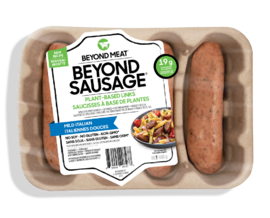Course:FNH200/Projects/2022/Beyond Meat Sausage
Introduction
Beyond Meat Sausage is the product from the company, Beyond Meat, Inc. It is a new form of plant-based protein option that being use as a meat substitute. It is the alternative product for pork sausages. According to Beyond Meat's website, Beyond sausage is 100% plant-based, kosher, gluten free, soy free, and no GMOs[1]. The product tastes similar with regular meat sausages and has similar appearance, but the ingredients did not have any animal related contents. The Beyond sausages have three flavour listed on the website: Brat Original, Sweet Italian, and Hot Italian. The company also introduced the breakfast Beyond Meat sausages to provide the consumer more choices. Since more people around the world is concerning about animal welfare and the environment, plant-based meat alternative is gaining more popularity and more exposure on the media. The attention given on the media not only promote this product, it also encourage more researchers to investigate in this field.
Beyond Meat and other plant based products have been on the increase with consumers being more open to vegetarian choices especially when they taste similar to their meat alternative. Some of the main reasons that consumers have started to switch include, supporting our individual health and supporting the health of the environment as well since these beyond meat products have less impact on greenhouse gas emissions, energy inputs, water use and land use.[2]

Beyond meat products are also not just available at supermarkets, Beyond meat has become a popular product at fast food places including being used by Pizza Hut. Pizza Hut created specific products for their partnership with beyond meat including The Great Beyond (a pizza with beyond Italian sausage crumbles) and Beyond Creamy Alfredo (pasta with beyond sausage crumbles).[3] Some more companies that beyond meat have partnered with include but are not limited to: Tim Horton’s, Costco, Subway, Denny’s, Safeway, Whole Foods, Save-On Foods, Walmart. With partnerships with fast food companies along with supermarkets the popularity of the beyond meat products has increased with products such as the beyond meat burger from A&W being very popular when first introduced that it was hard to find them in stock at many locations.
Studies done on the effect of Beyond Meat products are more clear when looking at the comparison of the Beyond Burger compared to a 4 oz. beef burger and the process of making the sausages does not differ greatly and so the studies show the effect of their sausages as well. Compared to the beef burger the Beyond Burger generates 90% less greenhouse gas emissions, requires 46% less energy, has >99% less impact on water scarcity and 93% less impact on land use than a ¼ pound of U.S. beef.[4]
Ingredients
The following is the ingredient list of the brat original beyond sausage extracted from Beyond Meat website, [1]:
Water, pea protein*, refined coconut oil, sunflower oil, natural flavor, contains 2% or less of: rice protein, faba bean protein, potato starch, salt, vegetable juice (for color), apple fiber, methylcellulose, citrus extract (to protect quality), calcium alginate casing.
| Ingredient | Function |
|---|---|
| Pea Protein | Is added as a main source of protein and to mimic the protein of meat alternatives |
| Refined Coconut Oil | Is added to provide the fat to the product as a replacement for fats provided by meat |
| Sunflower Oil | Is added to provide the fat to the product as a replacement for fats provided by meat |
| Natural Flavours | Adds the color and flavour to the final product and the texture of meat when cooked |
| Rice Protein | Provides the protein content |
| Faba Bean Protein | Provides the protein content |
| Potato Starch | Carbohydrate responsible for the texture of the product |
| Vegetable Juice | Added for color |
| Salt/Iron/Calcium/Potassium | Minerals added to provide the nutrients in the sausages. |
| Apple Fiber | Provide meat like texture and taste |
| Methylcellulose | Thickening and emulsifying additive to help in the blending of the ingredients |
| Citrus Extract | Added to protect quality of product |
| Calcium Alginate Casing | Vegan alternative made from seaweed to mimic the casing of meat sausages |
Food Additives
Methylcellulose, Sunflower lecithin, Citric acid, niacin [vitamin B3], pyridoxine hydrochloride [vitamin B6], thiamine hydrochloride [vitamin B1], riboflavin [vitamin B2], folic acid [vitamin B9], cyanocobalamin [vitamin B12], calcium pantothenate, biotin, zinc sulphate, ferric orthophosphate.
Comparison with Regular Meat Sausages
Compared with regular pork sausage, Beyond sausage contains less calories, fat, sodium, and cholesterol, but it has more protein and carbohydrates. It really depends on the situation to determine whether beyond sausage is more healthier than soy products or meat products. For people want to control their high blood pressure, they should limit their intake on products with too much salt, such as the beyond meat sausage. However, for people who want to limit saturate fat intake due to heart health concerns, the beyond meat sausage might be a better alternative to regular meat sausage. [5] The vitamin and mineral content is also significantly higher in Beyond Meat sausages, which is appealing to its consumers.
Below is the summary for some major nutritional facts from Beyond Sausage and pork sausage, the pork sausage data used here is from one of the leading brand in Canada[6]:
| Beyond Sausage | Pork Sausage | |
|---|---|---|
| Calories | ||
| Proteins (g) | ||
| Total Fats (g) | ||
| Total Sugar (g) | ||
| Carbohydrate (g) | ||
| Cholesterol (mg) | ||
| Sodium (mg) |

Package and Storage
Packaging

Beyond Sausages are vacuum packaged to maximize shelf life and prevent bacterial growth that could spoil the product. The actual packaging itself has a very simple design as the base holding the sausages is made out of cardboard. The cardboard tray is then covered with a polyethylene film. The label sticker is then attached to the film layer. When comparing this packaging to the regular meat sausages, the beyond meat products are more environmentally friendly. Most regular meat products are placed in foam trays which are not 100% recyclable or biodegradable like cardboard. They also use a lot more plastic to cover their meat products in comparison to Beyond Sausages. [7]
Best Storage Condition
Beyond Sausages usually come frozen and are meant to be kept in the freezer until it is time to thaw and eat them. Once opened and thawed the Beyond Meat Website states that they have a 7 day shelf life and should not be refrozen. Compared to regular sausage, once cooked, they are good for 3-4 days after which they must be refrozen. [8]
Food Processing
After all the processing, would it still be more environmental friendly than the regular meat?
Beyond meat products including the Beyond Meat sausages are not genetically modified. According to the official beyond meat website, The sausages are made similar to the meat alternatives. First the protein, fat, minerals, carbs and water are gathered just as they would be for meat products but plants are used instead. The three main steps in the process include heating, cooling and applying pressure to the proteins.[1] The company process the pea protein to mimic the structure of meat protein. They use alkaline conditions to form the protein into a dough, then force the dough under pressure to denature and align the protein into a fibrous net work similar to meat. Finally, they cool done the vegetable protein and set it into a fix fibrous structure.[9] The Beyond Meat is then put into the casing, which is made of calcium alginate. The calcium alginate casing of the sausages are made by breaking seaweed into pieces and stair them with a hot solution of sodium carbonate to dissolve into a thick slurry. The slurry is then filtered, diluted with water, filter again with a filter aid, and then made into the thin film coating the beyond meat sausage.[10] The beyond meat sausages are bought frozen from stores and is likely gone through the process of plate freezing to finish the processing of the sausages.
The processing and production of these beyond meat products are also more environmentally friendly compared to their meat alternatives. The main components of the beyond meat sausage include pea protein, and coconut oil. The use of pea proteins rather than beef sees a significant positive impact to both land use and greenhouse gas emissions. [11]
Overall Personal Choice?
Environmental Perspective
Many people decided to buy beyond meat sausage because it is environmental friendly. In the research partnered with University of Michigan, the researcher stated that Beyond Meat uses 99% less water, 93% less land, 90% fewer greenhouse gases, and 46% less energy than beef burger[12]. However, there are some criticisms among Beyond Meat company's transparency in their actual sustainability data [13].
Downside to Plant-Based Meat Alternative
One major downside for all plant-based meat alternative is the price. If compare the price of the Beyond sausage with other protein alternative such as tofu, the cost of Beyond sausage is at least 2 times higher than tofu. When considering the ingredient lists, there are more food additives in plant-based meat alternative product. The food additives are added to mimic the flavour and texture of meat. Although having more food additives does not equal to less healthy, some people may be more concerned about the usage of these products in food.
Possible Exam Questions
In regards to current food trends, Beyond Sausage would fit under the following :
- Meat Alternatives
- Sustainable Packaging
- Calm-Promoting Foods
- Both 1 and 2
- All of the Above
This could be an exam question as beyond meat is a very popular topic when it comes to new and current food trends. Beyond meat has been huge for the growth of plant based alternatives for both vegetarians and meat lovers as well. We also see the sustainable packaging as another big plus for the product that is important in today's climate where society is becoming more aware and proactive with improving the environment.
References
- ↑ 1.0 1.1 1.2 "Brats, Hot Sausage, & Italian sausage: Beyond meat". Archived from the original on Aug. 12, 2022. Check date values in:
|archive-date=(help) - ↑ "Beyond Meat elevates veggie burgers' taste, but what about nutrition?". Retrieved August. 14, 2022. Check date values in:
|access-date=(help) - ↑ "PIZZA HUT® AND BEYOND MEAT® STRENGTHEN PARTNERSHIP WITH DEBUT OF BEYOND ITALIAN SAUSAGE™ CRUMBLES AT LOCATIONS ACROSS CANADA". Retrieved August. 14, 2022. Check date values in:
|access-date=(help) - ↑ "Beyond Meat's Beyond Burger Life Cycle Assessment: A detailed comparison between a plant-based and an animal-based protein source". Retrieved August. 14, 2022. Check date values in:
|access-date=(help) - ↑ Reinberg, Steven (June 17, 2021). "How Healthy Are the New Plant-Based 'Fake Meats'?". WebMD.
- ↑ "Original recipe bratwurst sausages". Johnsonville Canada. Check date values in:
|archive-date=(help) - ↑ "Daily Footprint Beyond Meat". August 14th 2022. Check date values in:
|date=(help) - ↑ "Beyond Sausage". August 14th 2022. Check date values in:
|date=(help) - ↑ "How Beyond Meat and Impossible Foods Make Their Plant-Based Burgers". Science Meets Food. Jan 22 2022. Check date values in:
|date=(help) - ↑ "ALGINATE". Food and Agriculture Organization of the United Nations.
- ↑ "Daily Footprint, #31 – Beyond Meat". Retrieved August, 14, 2022. Check date values in:
|access-date=(help) - ↑ Heller, Martin C. and Gregory A. Keoleian. (2018) “Beyond Meat's Beyond Burger Life Cycle Assessment: A detailed comparison between a plant-based and an animal-based protein source.” CSS Report, University of Michigan: Ann Arbor 1-38.
- ↑ "Better Brands: Is beyond meat sustainable?". Sustainable Review. Jan. 29, 2021. Check date values in:
|date=, |archive-date=(help)